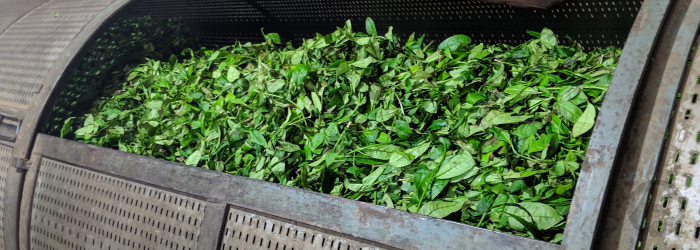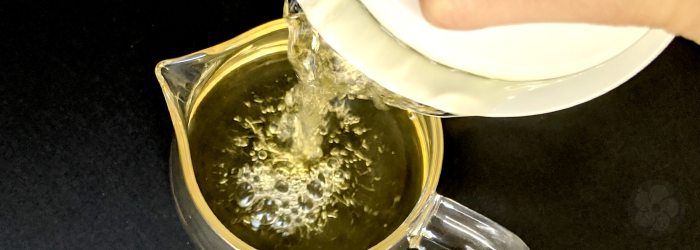Types of Tea: 3 Degrees of Blending

Though most types of tea are defined by some combination of their variety, harvest date, provenance, and crafting style, there is typically a range of quality within each broadly defined type. In the interest of increasing yields, lower quality teas are grown quickly, in hotter climates or with fertilizers, and thereby sacrifice natural flavor quality. These become the base tea leaves for mass produced blends, a widespread practice which has given the term 'blended' a negative connotation among serious tea drinkers.
Learn more about the ways in which flavors are added to tea >>
But not all blended teas are necessarily bad. In fact, though we take great pride in the single-origin nature of our teas, not every tea we love enough to carry is completely 'unblended'. While blends can be crafted with the aim of concealing low-quality flavors, blending can also be a tool that allows skilled tea-makers to create new and intriguing flavors of pure tea, or simply to create flavor that is more consistent from year to year. There is a range of quality in blended teas, and today we’re breaking the spectrum down into three distinct parts.
Unblended Tea
The most prized teas of any major tea category are almost never blended. Whether they are plucked early in spring, harvested at high elevations, or expertly crafted in small batches, the unique qualities of each lot of tea are preserved by keeping them separate from one another. These teas not only come from a single place of origin, but also a single variety of Camellia sinensis, and a single day’s harvest. The leaves are picked and processed together to create a batch of finished tea that is distinct, even from other harvests from the same farm.
Find out how flavor develops at each stage of the growth process >>
The differences in flavor between these unblended lots can be traced directly to natural factors both grand and minute: terroir that differs from farm to farm within the same region, unique crafting techniques passed down through different families, even weather conditions that change from week to week or day to day. When we source teas each year, we typically taste several of these distinct lots to select the best iteration to suit our palates (and those of our customers).
Depending on the factors that create each lot’s flavor profile, each batch can be highly limited in quantity. The best unblended teas are typically the priciest teas on the market, due to the specificity of growing and crafting conditions and their inherent rarity. Blending such teas is a dilution of the highest quality lots, and generally avoided. The result is that flavors and quality in this category can vary greatly: from farm to farm, year to year, or even from week to week during the same harvest season.
Learn how changing weather conditions can change tea harvests >>
Blended Varieties
Many teas, however, can be considered ‘single origin’ without being completely unblended. A local processing facility might collect crops from several growers in a single region that don’t have their own equipment. A single farm might combine the harvests from several days in a row to balance flavor from varied weather conditions. Or a single farm might grow a range of Camellia sinensis varieties and combine them to create new and unusual flavors, as with our Three Cultivar Red.
Large companies also use this strategy to create consistency across mass-market product lines. Most employ expert blenders, who specialize in creating the distinctive taste of each brand. By buying from many producers each year and blending batches, they are able to build their reputation on a specific flavor quality that remains the same season after season and year after year, even when growing or crafting conditions change.
Find out how mass-produced teas go from farm to cup >>
This type of blending is used in many different grades of tea, from premium whole leaf selections to common bagged teas made with fannings. Thus, calling a tea ‘blended’ says almost nothing about its overall quality. In fact, a blended tea can often taste better than a poor example of unblended tea, since blending is often undertaken to improve the flavor profile of single origin teas that suffer from imperfect or unpredictable weather conditions.
Blended Flavorings
Usually, however, when we say ‘blended’ teas, we are referring to teas that are blended with herbs, flowers, or spices. Sometimes, the term also refers to mass-market blends used as a base tea for artificial flavorings. In this context, the term takes on a negative connotation, since the addition of extra flavors can disguise the natural flavor of the blended tea leaves.
Learn why we prefer to drink teas without any added flavors or sweeteners >>
Additions might also be included simply to stretch the size of a batch of tea, or to increase seasonal consistency of teas that are not so expertly blended. Traditionally, blends like Genmaicha or Chai were created to increase the quantity and improve the flavor of the cheapest teas, making them more accessible all year round to working class tea drinkers.
Today, blends that visibly contain non-tea ingredients are usually more expensive than artificially flavored teas, but top-shelf tea leaves are almost never used to create these blends. The focus is on the added ingredients, meaning the base teas are typically more prone to bitterness, astringency, and flavor that would fall flat on its own.
Find out why premium teas taste better in this video:
Of course, this isn’t a firm rule. We ourselves make a few blends in-house, using everyday teas that have passed our stringent tasting standards on their own as well. We much prefer our Superior Earl Grey, made with dried orange peel, to the artificial bergamot flavoring added to most Earl Grey teas, or the freshly dried mint in our Moroccan Mint blend to the stale mint teas found on grocery store shelves. As usual, the simple distinction between ‘blended’ and ‘unblended’ teas falls short of describing the complex array of options. Teas in each of these categories span a range of quality, and ultimately, the only quality that matters is whether the finished tea pleases your palate.
What are your favorite blended teas? Let us know what you think in the comments below!
Sign up for our newsletter to get blog updates in your inbox!







Comments on this post (0)